Nguyen Ba Cuong - BTEC HND Unit 6 Project: Talent Management Analysis
VerifiedAdded on 2021/10/06
|21
|5362
|90
Report
AI Summary
This report, submitted for a BTEC Level 4 HND Diploma in Business, Unit 6: Management a Successful Business Project, details a project focused on talent management within different age groups. It encompasses a comprehensive project management plan, including cost analysis, scope definition, time management, milestone schedules, quality control, communication strategies, and risk assessment. The report includes a work breakdown structure, a Gantt chart for project timeline visualization, and both qualitative and quantitative research methods. The primary data section presents findings on talent management clarification, the identification of age groups, and the methods used for talent management within each group. Furthermore, the research methods section describes the use of primary and secondary research, along with quantitative and qualitative approaches. The report concludes with a summary of the findings and a bibliography of cited sources.
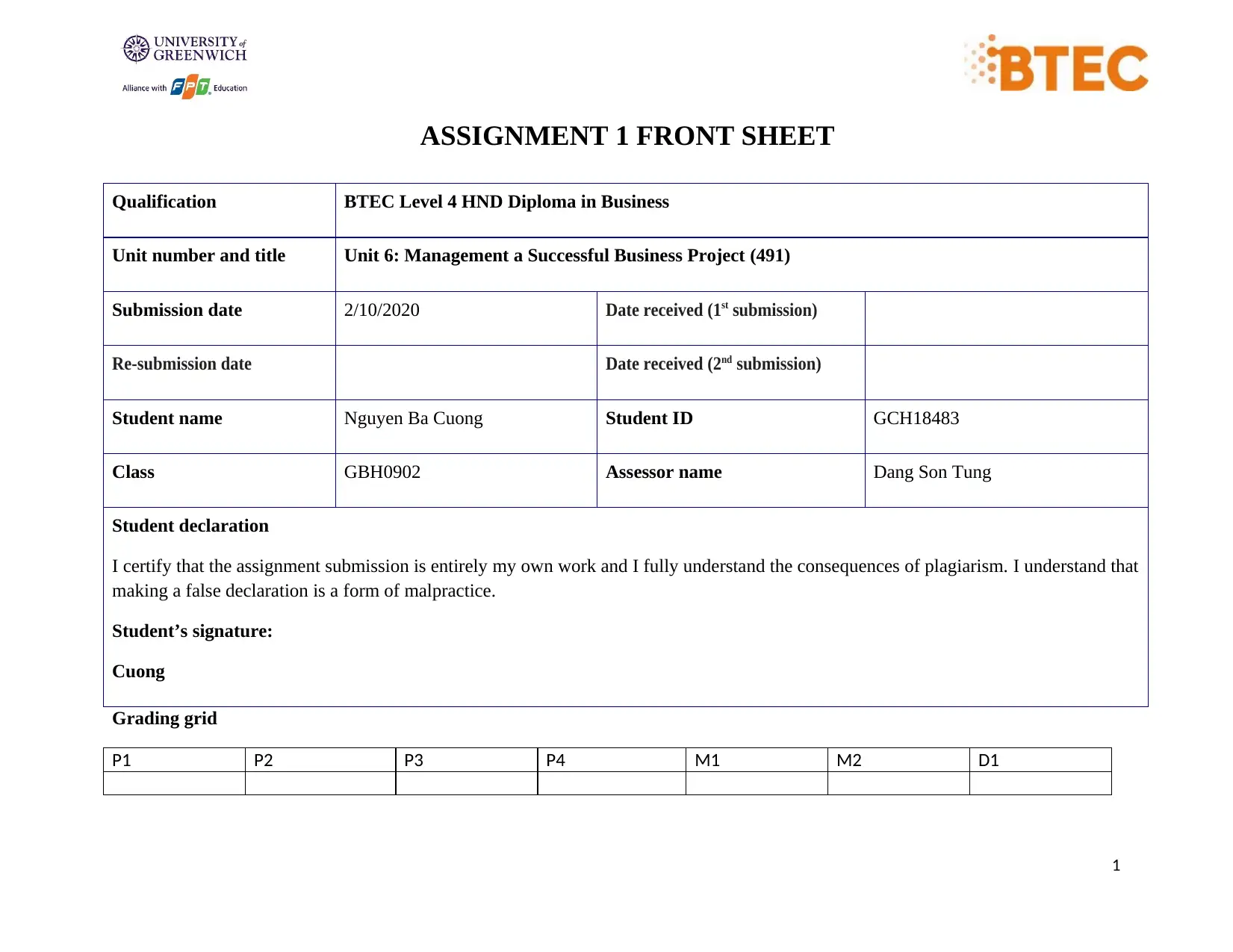
ASSIGNMENT 1 FRONT SHEET
Qualification BTEC Level 4 HND Diploma in Business
Unit number and title Unit 6: Management a Successful Business Project (491)
Submission date 2/10/2020 Date received (1 st submission)
Re-submission date Date received (2 nd submission)
Student name Nguyen Ba Cuong Student ID GCH18483
Class GBH0902 Assessor name Dang Son Tung
Student declaration
I certify that the assignment submission is entirely my own work and I fully understand the consequences of plagiarism. I understand that
making a false declaration is a form of malpractice.
Student’s signature:
Cuong
Grading grid
P1 P2 P3 P4 M1 M2 D1
1
Qualification BTEC Level 4 HND Diploma in Business
Unit number and title Unit 6: Management a Successful Business Project (491)
Submission date 2/10/2020 Date received (1 st submission)
Re-submission date Date received (2 nd submission)
Student name Nguyen Ba Cuong Student ID GCH18483
Class GBH0902 Assessor name Dang Son Tung
Student declaration
I certify that the assignment submission is entirely my own work and I fully understand the consequences of plagiarism. I understand that
making a false declaration is a form of malpractice.
Student’s signature:
Cuong
Grading grid
P1 P2 P3 P4 M1 M2 D1
1
Paraphrase This Document
Need a fresh take? Get an instant paraphrase of this document with our AI Paraphraser
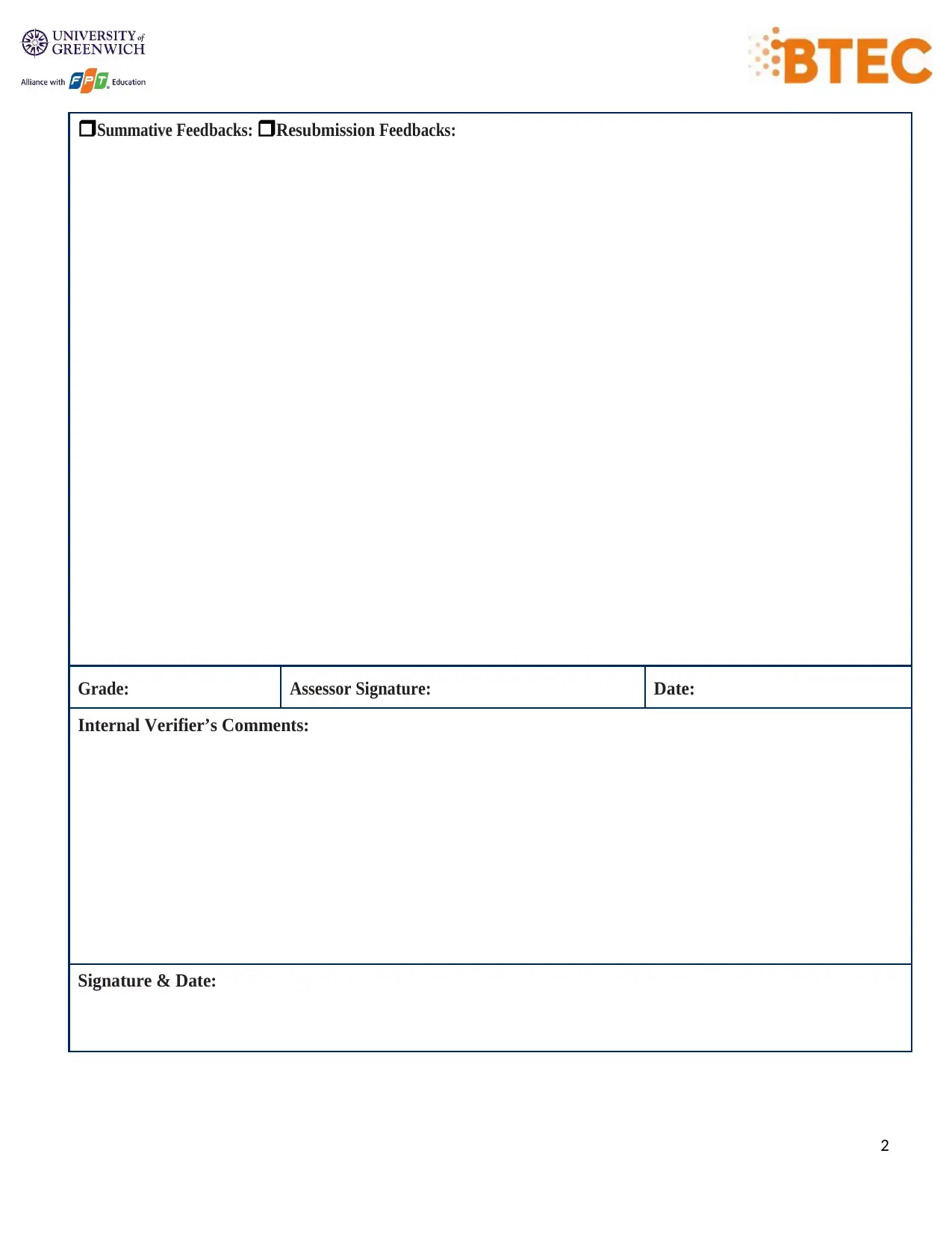
Summative Feedbacks: Resubmission Feedbacks:
Grade: Assessor Signature: Date:
Internal Verifier’s Comments:
Signature & Date:
2
Grade: Assessor Signature: Date:
Internal Verifier’s Comments:
Signature & Date:
2
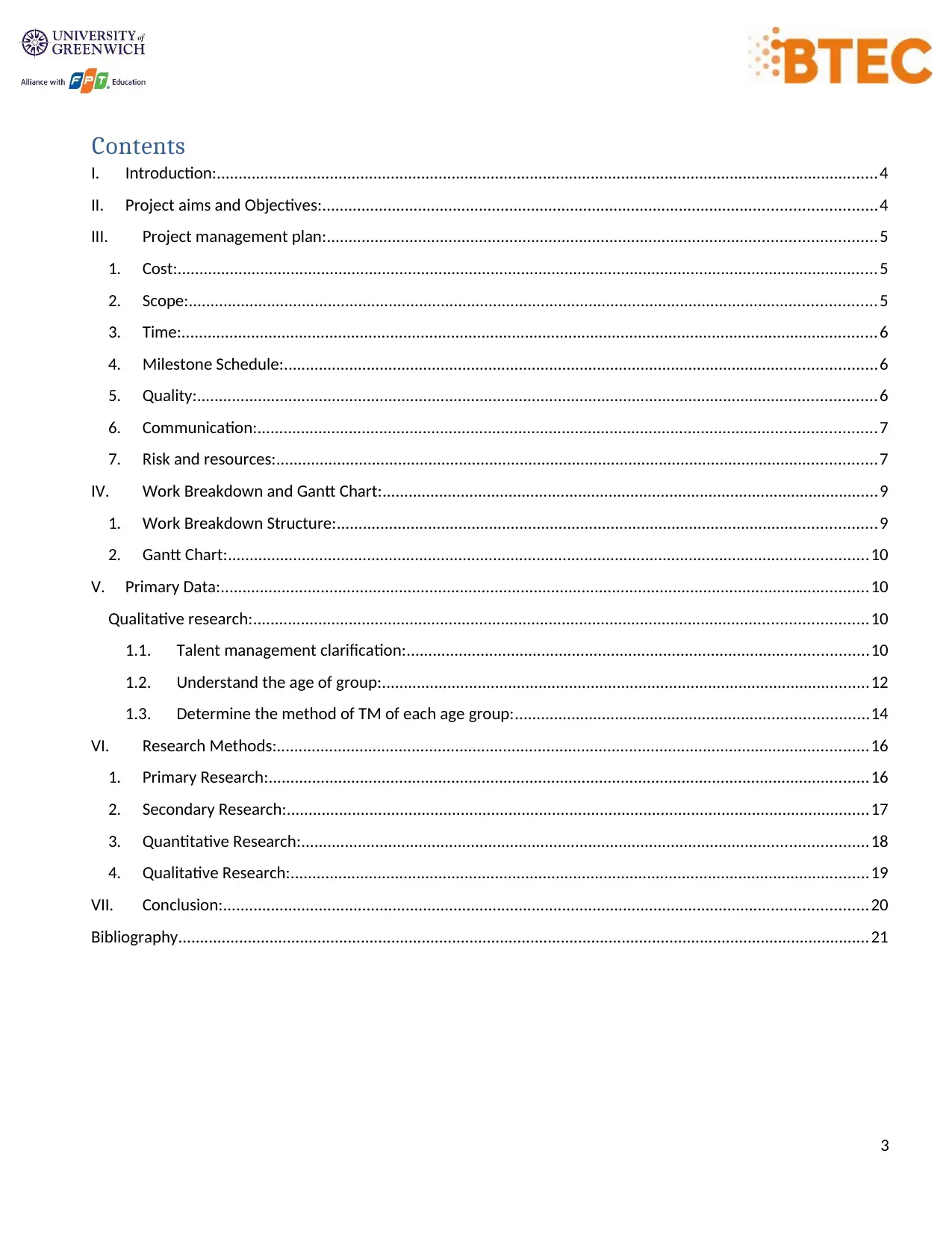
Contents
I. Introduction:........................................................................................................................................................4
II. Project aims and Objectives:...............................................................................................................................4
III. Project management plan:..............................................................................................................................5
1. Cost:.................................................................................................................................................................5
2. Scope:..............................................................................................................................................................5
3. Time:................................................................................................................................................................6
4. Milestone Schedule:........................................................................................................................................6
5. Quality:............................................................................................................................................................6
6. Communication:..............................................................................................................................................7
7. Risk and resources:..........................................................................................................................................7
IV. Work Breakdown and Gantt Chart:..................................................................................................................9
1. Work Breakdown Structure:............................................................................................................................9
2. Gantt Chart:...................................................................................................................................................10
V. Primary Data:.....................................................................................................................................................10
Qualitative research:.............................................................................................................................................10
1.1. Talent management clarification:..........................................................................................................10
1.2. Understand the age of group:................................................................................................................12
1.3. Determine the method of TM of each age group:.................................................................................14
VI. Research Methods:........................................................................................................................................16
1. Primary Research:..........................................................................................................................................16
2. Secondary Research:......................................................................................................................................17
3. Quantitative Research:..................................................................................................................................18
4. Qualitative Research:.....................................................................................................................................19
VII. Conclusion:....................................................................................................................................................20
Bibliography...............................................................................................................................................................21
3
I. Introduction:........................................................................................................................................................4
II. Project aims and Objectives:...............................................................................................................................4
III. Project management plan:..............................................................................................................................5
1. Cost:.................................................................................................................................................................5
2. Scope:..............................................................................................................................................................5
3. Time:................................................................................................................................................................6
4. Milestone Schedule:........................................................................................................................................6
5. Quality:............................................................................................................................................................6
6. Communication:..............................................................................................................................................7
7. Risk and resources:..........................................................................................................................................7
IV. Work Breakdown and Gantt Chart:..................................................................................................................9
1. Work Breakdown Structure:............................................................................................................................9
2. Gantt Chart:...................................................................................................................................................10
V. Primary Data:.....................................................................................................................................................10
Qualitative research:.............................................................................................................................................10
1.1. Talent management clarification:..........................................................................................................10
1.2. Understand the age of group:................................................................................................................12
1.3. Determine the method of TM of each age group:.................................................................................14
VI. Research Methods:........................................................................................................................................16
1. Primary Research:..........................................................................................................................................16
2. Secondary Research:......................................................................................................................................17
3. Quantitative Research:..................................................................................................................................18
4. Qualitative Research:.....................................................................................................................................19
VII. Conclusion:....................................................................................................................................................20
Bibliography...............................................................................................................................................................21
3
⊘ This is a preview!⊘
Do you want full access?
Subscribe today to unlock all pages.

Trusted by 1+ million students worldwide
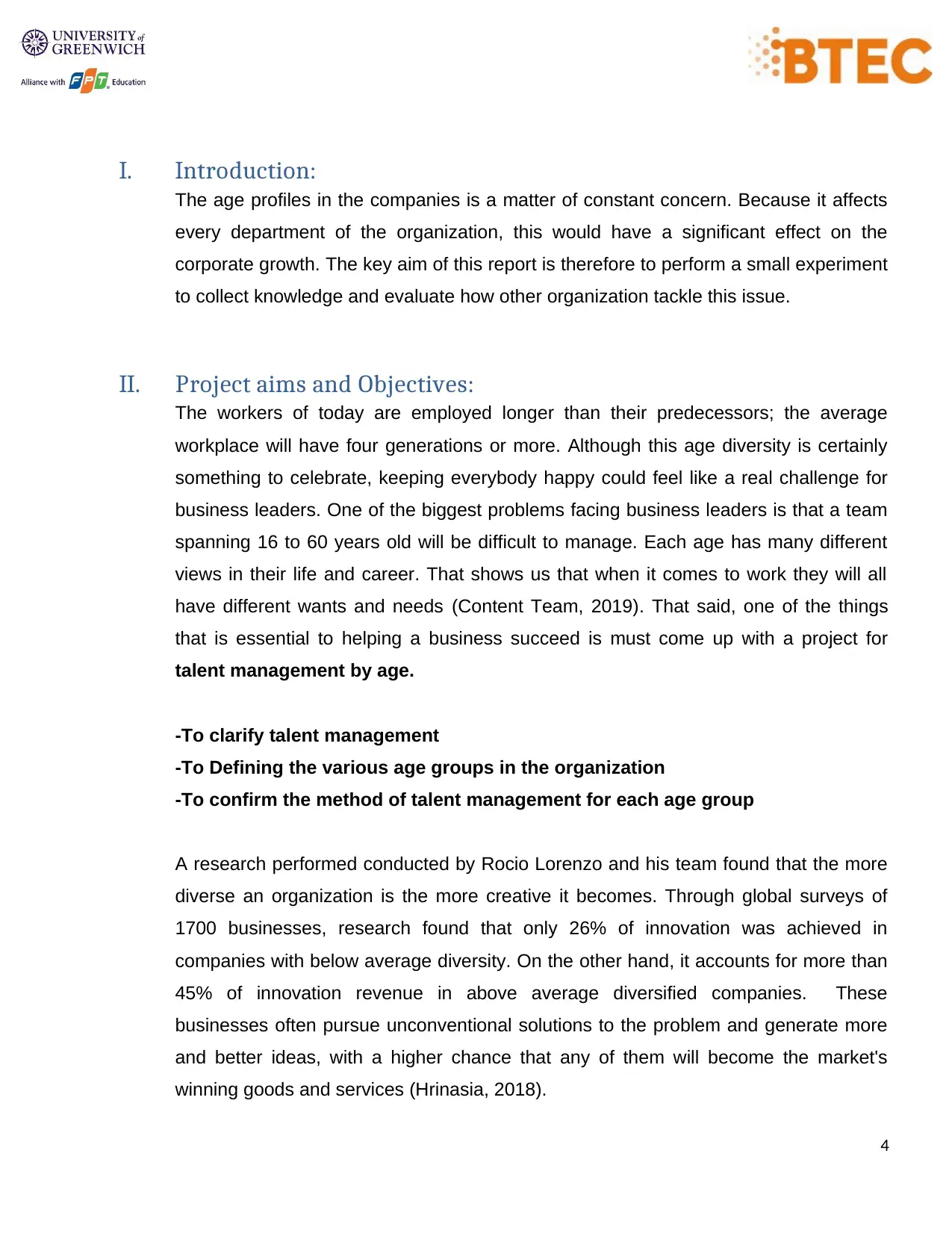
I. Introduction:
The age profiles in the companies is a matter of constant concern. Because it affects
every department of the organization, this would have a significant effect on the
corporate growth. The key aim of this report is therefore to perform a small experiment
to collect knowledge and evaluate how other organization tackle this issue.
II. Project aims and Objectives:
The workers of today are employed longer than their predecessors; the average
workplace will have four generations or more. Although this age diversity is certainly
something to celebrate, keeping everybody happy could feel like a real challenge for
business leaders. One of the biggest problems facing business leaders is that a team
spanning 16 to 60 years old will be difficult to manage. Each age has many different
views in their life and career. That shows us that when it comes to work they will all
have different wants and needs (Content Team, 2019). That said, one of the things
that is essential to helping a business succeed is must come up with a project for
talent management by age.
-To clarify talent management
-To Defining the various age groups in the organization
-To confirm the method of talent management for each age group
A research performed conducted by Rocio Lorenzo and his team found that the more
diverse an organization is the more creative it becomes. Through global surveys of
1700 businesses, research found that only 26% of innovation was achieved in
companies with below average diversity. On the other hand, it accounts for more than
45% of innovation revenue in above average diversified companies. These
businesses often pursue unconventional solutions to the problem and generate more
and better ideas, with a higher chance that any of them will become the market's
winning goods and services (Hrinasia, 2018).
4
The age profiles in the companies is a matter of constant concern. Because it affects
every department of the organization, this would have a significant effect on the
corporate growth. The key aim of this report is therefore to perform a small experiment
to collect knowledge and evaluate how other organization tackle this issue.
II. Project aims and Objectives:
The workers of today are employed longer than their predecessors; the average
workplace will have four generations or more. Although this age diversity is certainly
something to celebrate, keeping everybody happy could feel like a real challenge for
business leaders. One of the biggest problems facing business leaders is that a team
spanning 16 to 60 years old will be difficult to manage. Each age has many different
views in their life and career. That shows us that when it comes to work they will all
have different wants and needs (Content Team, 2019). That said, one of the things
that is essential to helping a business succeed is must come up with a project for
talent management by age.
-To clarify talent management
-To Defining the various age groups in the organization
-To confirm the method of talent management for each age group
A research performed conducted by Rocio Lorenzo and his team found that the more
diverse an organization is the more creative it becomes. Through global surveys of
1700 businesses, research found that only 26% of innovation was achieved in
companies with below average diversity. On the other hand, it accounts for more than
45% of innovation revenue in above average diversified companies. These
businesses often pursue unconventional solutions to the problem and generate more
and better ideas, with a higher chance that any of them will become the market's
winning goods and services (Hrinasia, 2018).
4
Paraphrase This Document
Need a fresh take? Get an instant paraphrase of this document with our AI Paraphraser
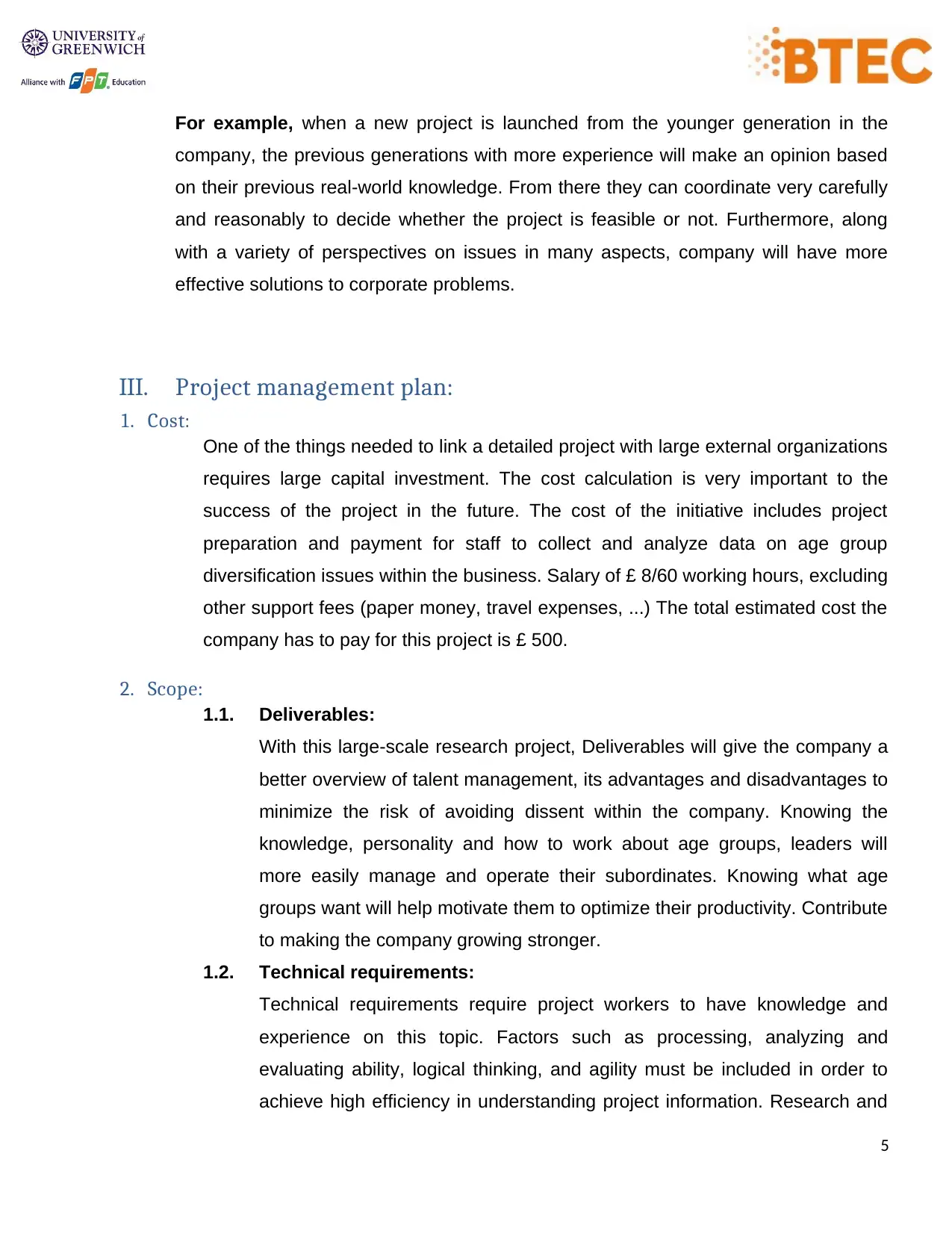
For example, when a new project is launched from the younger generation in the
company, the previous generations with more experience will make an opinion based
on their previous real-world knowledge. From there they can coordinate very carefully
and reasonably to decide whether the project is feasible or not. Furthermore, along
with a variety of perspectives on issues in many aspects, company will have more
effective solutions to corporate problems.
III. Project management plan:
1. Cost:
One of the things needed to link a detailed project with large external organizations
requires large capital investment. The cost calculation is very important to the
success of the project in the future. The cost of the initiative includes project
preparation and payment for staff to collect and analyze data on age group
diversification issues within the business. Salary of £ 8/60 working hours, excluding
other support fees (paper money, travel expenses, ...) The total estimated cost the
company has to pay for this project is £ 500.
2. Scope:
1.1. Deliverables:
With this large-scale research project, Deliverables will give the company a
better overview of talent management, its advantages and disadvantages to
minimize the risk of avoiding dissent within the company. Knowing the
knowledge, personality and how to work about age groups, leaders will
more easily manage and operate their subordinates. Knowing what age
groups want will help motivate them to optimize their productivity. Contribute
to making the company growing stronger.
1.2. Technical requirements:
Technical requirements require project workers to have knowledge and
experience on this topic. Factors such as processing, analyzing and
evaluating ability, logical thinking, and agility must be included in order to
achieve high efficiency in understanding project information. Research and
5
company, the previous generations with more experience will make an opinion based
on their previous real-world knowledge. From there they can coordinate very carefully
and reasonably to decide whether the project is feasible or not. Furthermore, along
with a variety of perspectives on issues in many aspects, company will have more
effective solutions to corporate problems.
III. Project management plan:
1. Cost:
One of the things needed to link a detailed project with large external organizations
requires large capital investment. The cost calculation is very important to the
success of the project in the future. The cost of the initiative includes project
preparation and payment for staff to collect and analyze data on age group
diversification issues within the business. Salary of £ 8/60 working hours, excluding
other support fees (paper money, travel expenses, ...) The total estimated cost the
company has to pay for this project is £ 500.
2. Scope:
1.1. Deliverables:
With this large-scale research project, Deliverables will give the company a
better overview of talent management, its advantages and disadvantages to
minimize the risk of avoiding dissent within the company. Knowing the
knowledge, personality and how to work about age groups, leaders will
more easily manage and operate their subordinates. Knowing what age
groups want will help motivate them to optimize their productivity. Contribute
to making the company growing stronger.
1.2. Technical requirements:
Technical requirements require project workers to have knowledge and
experience on this topic. Factors such as processing, analyzing and
evaluating ability, logical thinking, and agility must be included in order to
achieve high efficiency in understanding project information. Research and
5
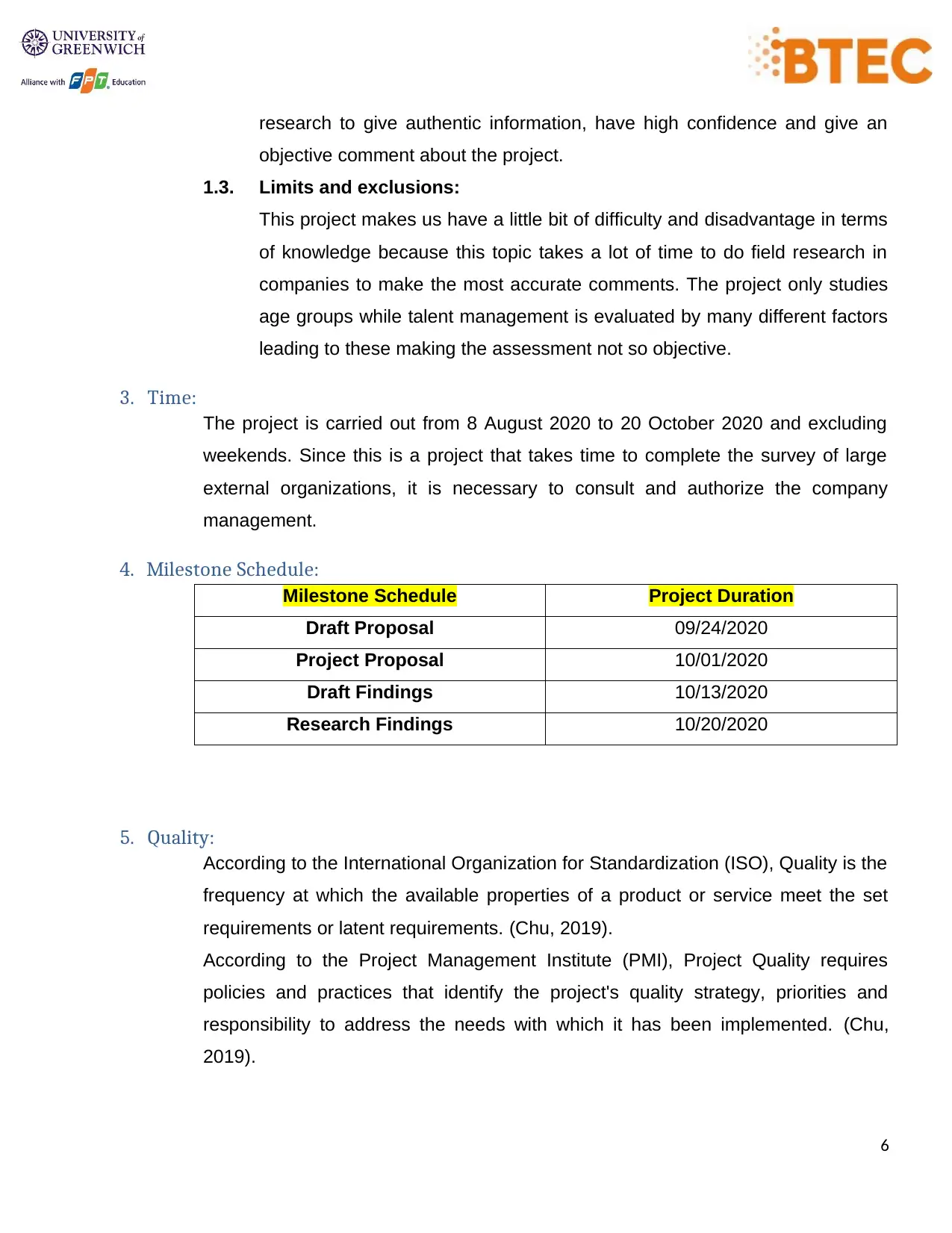
research to give authentic information, have high confidence and give an
objective comment about the project.
1.3. Limits and exclusions:
This project makes us have a little bit of difficulty and disadvantage in terms
of knowledge because this topic takes a lot of time to do field research in
companies to make the most accurate comments. The project only studies
age groups while talent management is evaluated by many different factors
leading to these making the assessment not so objective.
3. Time:
The project is carried out from 8 August 2020 to 20 October 2020 and excluding
weekends. Since this is a project that takes time to complete the survey of large
external organizations, it is necessary to consult and authorize the company
management.
4. Milestone Schedule:
Milestone Schedule Project Duration
Draft Proposal 09/24/2020
Project Proposal 10/01/2020
Draft Findings 10/13/2020
Research Findings 10/20/2020
5. Quality:
According to the International Organization for Standardization (ISO), Quality is the
frequency at which the available properties of a product or service meet the set
requirements or latent requirements. (Chu, 2019).
According to the Project Management Institute (PMI), Project Quality requires
policies and practices that identify the project's quality strategy, priorities and
responsibility to address the needs with which it has been implemented. (Chu,
2019).
6
objective comment about the project.
1.3. Limits and exclusions:
This project makes us have a little bit of difficulty and disadvantage in terms
of knowledge because this topic takes a lot of time to do field research in
companies to make the most accurate comments. The project only studies
age groups while talent management is evaluated by many different factors
leading to these making the assessment not so objective.
3. Time:
The project is carried out from 8 August 2020 to 20 October 2020 and excluding
weekends. Since this is a project that takes time to complete the survey of large
external organizations, it is necessary to consult and authorize the company
management.
4. Milestone Schedule:
Milestone Schedule Project Duration
Draft Proposal 09/24/2020
Project Proposal 10/01/2020
Draft Findings 10/13/2020
Research Findings 10/20/2020
5. Quality:
According to the International Organization for Standardization (ISO), Quality is the
frequency at which the available properties of a product or service meet the set
requirements or latent requirements. (Chu, 2019).
According to the Project Management Institute (PMI), Project Quality requires
policies and practices that identify the project's quality strategy, priorities and
responsibility to address the needs with which it has been implemented. (Chu,
2019).
6
⊘ This is a preview!⊘
Do you want full access?
Subscribe today to unlock all pages.

Trusted by 1+ million students worldwide
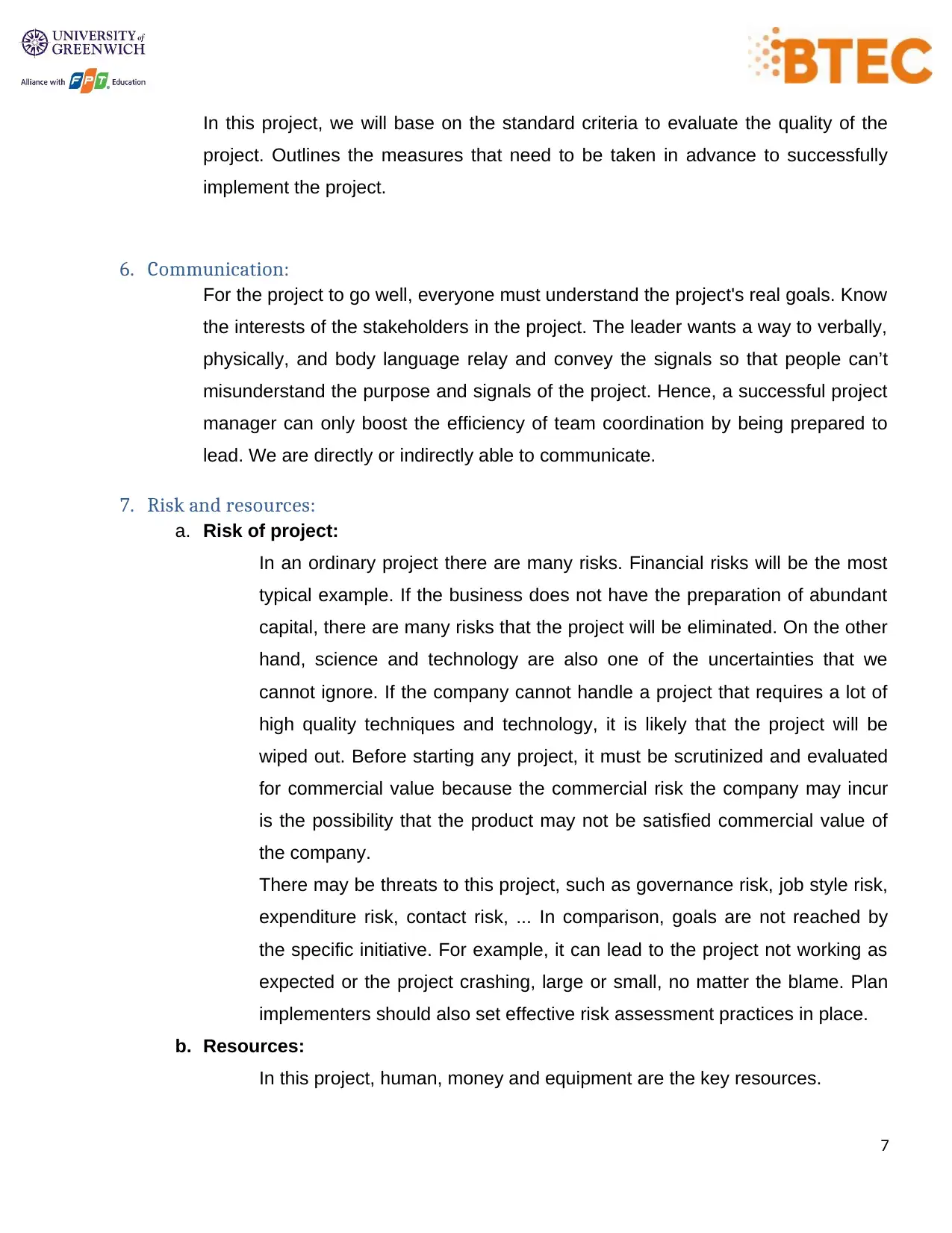
In this project, we will base on the standard criteria to evaluate the quality of the
project. Outlines the measures that need to be taken in advance to successfully
implement the project.
6. Communication:
For the project to go well, everyone must understand the project's real goals. Know
the interests of the stakeholders in the project. The leader wants a way to verbally,
physically, and body language relay and convey the signals so that people can’t
misunderstand the purpose and signals of the project. Hence, a successful project
manager can only boost the efficiency of team coordination by being prepared to
lead. We are directly or indirectly able to communicate.
7. Risk and resources:
a. Risk of project:
In an ordinary project there are many risks. Financial risks will be the most
typical example. If the business does not have the preparation of abundant
capital, there are many risks that the project will be eliminated. On the other
hand, science and technology are also one of the uncertainties that we
cannot ignore. If the company cannot handle a project that requires a lot of
high quality techniques and technology, it is likely that the project will be
wiped out. Before starting any project, it must be scrutinized and evaluated
for commercial value because the commercial risk the company may incur
is the possibility that the product may not be satisfied commercial value of
the company.
There may be threats to this project, such as governance risk, job style risk,
expenditure risk, contact risk, ... In comparison, goals are not reached by
the specific initiative. For example, it can lead to the project not working as
expected or the project crashing, large or small, no matter the blame. Plan
implementers should also set effective risk assessment practices in place.
b. Resources:
In this project, human, money and equipment are the key resources.
7
project. Outlines the measures that need to be taken in advance to successfully
implement the project.
6. Communication:
For the project to go well, everyone must understand the project's real goals. Know
the interests of the stakeholders in the project. The leader wants a way to verbally,
physically, and body language relay and convey the signals so that people can’t
misunderstand the purpose and signals of the project. Hence, a successful project
manager can only boost the efficiency of team coordination by being prepared to
lead. We are directly or indirectly able to communicate.
7. Risk and resources:
a. Risk of project:
In an ordinary project there are many risks. Financial risks will be the most
typical example. If the business does not have the preparation of abundant
capital, there are many risks that the project will be eliminated. On the other
hand, science and technology are also one of the uncertainties that we
cannot ignore. If the company cannot handle a project that requires a lot of
high quality techniques and technology, it is likely that the project will be
wiped out. Before starting any project, it must be scrutinized and evaluated
for commercial value because the commercial risk the company may incur
is the possibility that the product may not be satisfied commercial value of
the company.
There may be threats to this project, such as governance risk, job style risk,
expenditure risk, contact risk, ... In comparison, goals are not reached by
the specific initiative. For example, it can lead to the project not working as
expected or the project crashing, large or small, no matter the blame. Plan
implementers should also set effective risk assessment practices in place.
b. Resources:
In this project, human, money and equipment are the key resources.
7
Paraphrase This Document
Need a fresh take? Get an instant paraphrase of this document with our AI Paraphraser
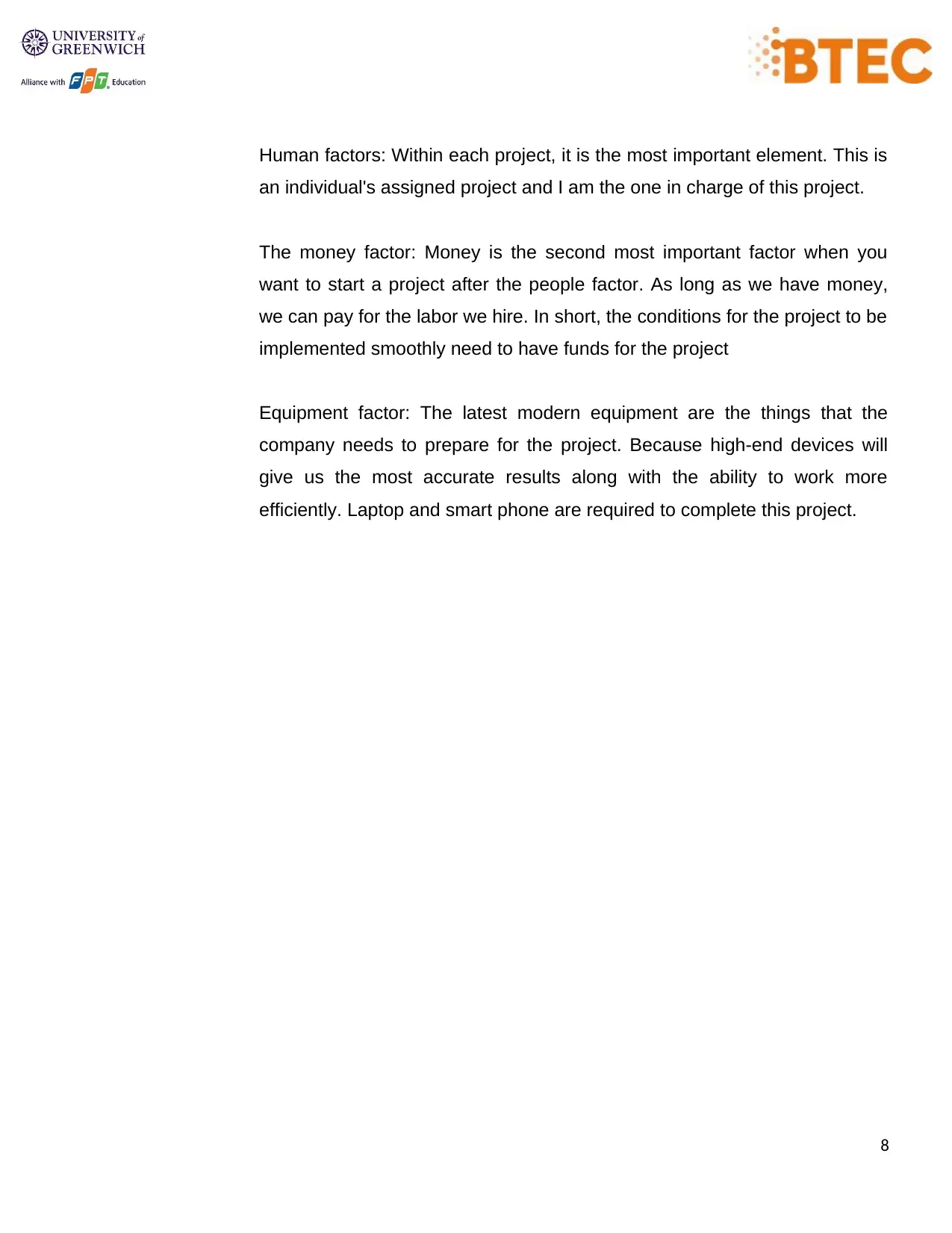
Human factors: Within each project, it is the most important element. This is
an individual's assigned project and I am the one in charge of this project.
The money factor: Money is the second most important factor when you
want to start a project after the people factor. As long as we have money,
we can pay for the labor we hire. In short, the conditions for the project to be
implemented smoothly need to have funds for the project
Equipment factor: The latest modern equipment are the things that the
company needs to prepare for the project. Because high-end devices will
give us the most accurate results along with the ability to work more
efficiently. Laptop and smart phone are required to complete this project.
8
an individual's assigned project and I am the one in charge of this project.
The money factor: Money is the second most important factor when you
want to start a project after the people factor. As long as we have money,
we can pay for the labor we hire. In short, the conditions for the project to be
implemented smoothly need to have funds for the project
Equipment factor: The latest modern equipment are the things that the
company needs to prepare for the project. Because high-end devices will
give us the most accurate results along with the ability to work more
efficiently. Laptop and smart phone are required to complete this project.
8
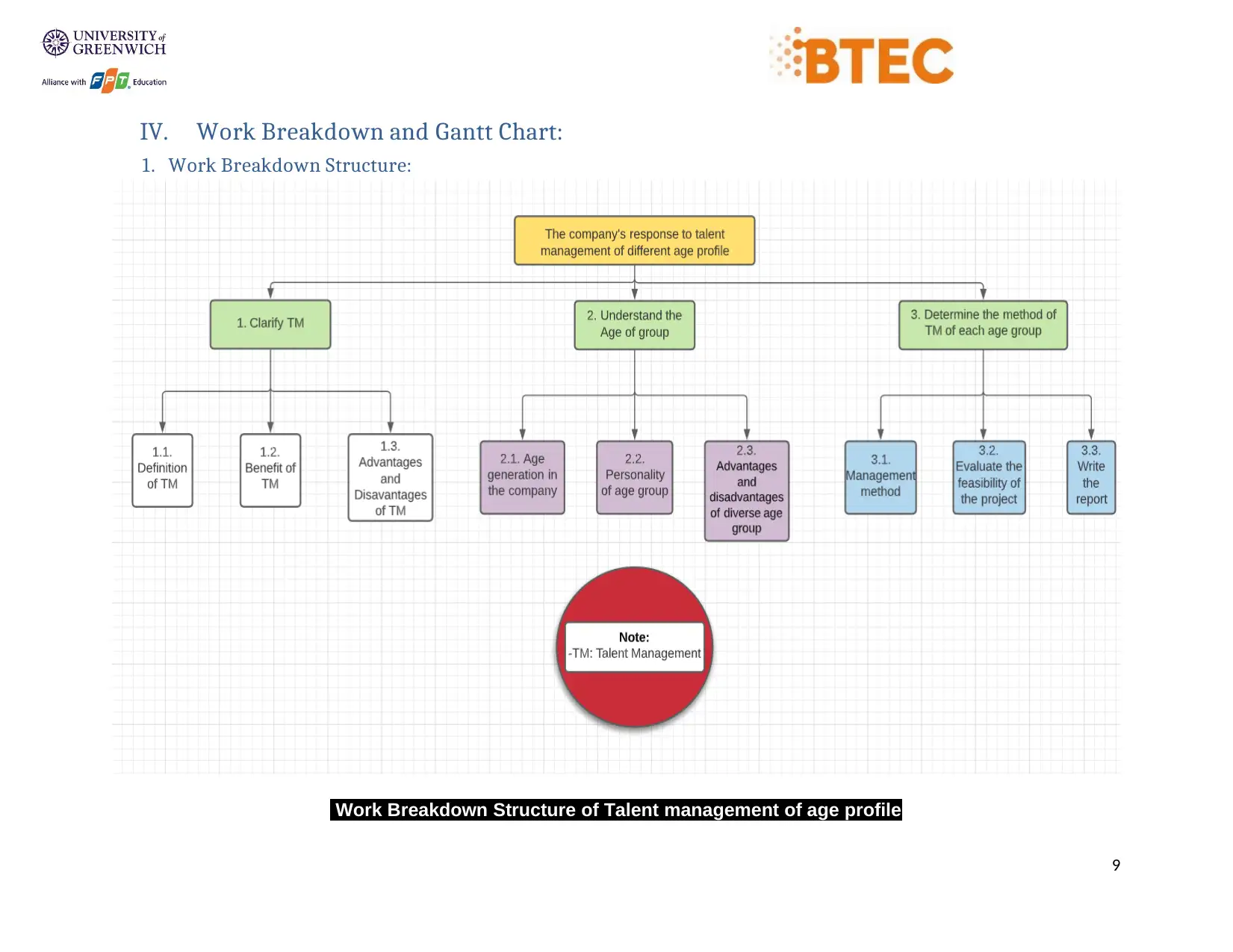
IV. Work Breakdown and Gantt Chart:
1. Work Breakdown Structure:
Work Breakdown Structure of Talent management of age profile
9
1. Work Breakdown Structure:
Work Breakdown Structure of Talent management of age profile
9
⊘ This is a preview!⊘
Do you want full access?
Subscribe today to unlock all pages.

Trusted by 1+ million students worldwide
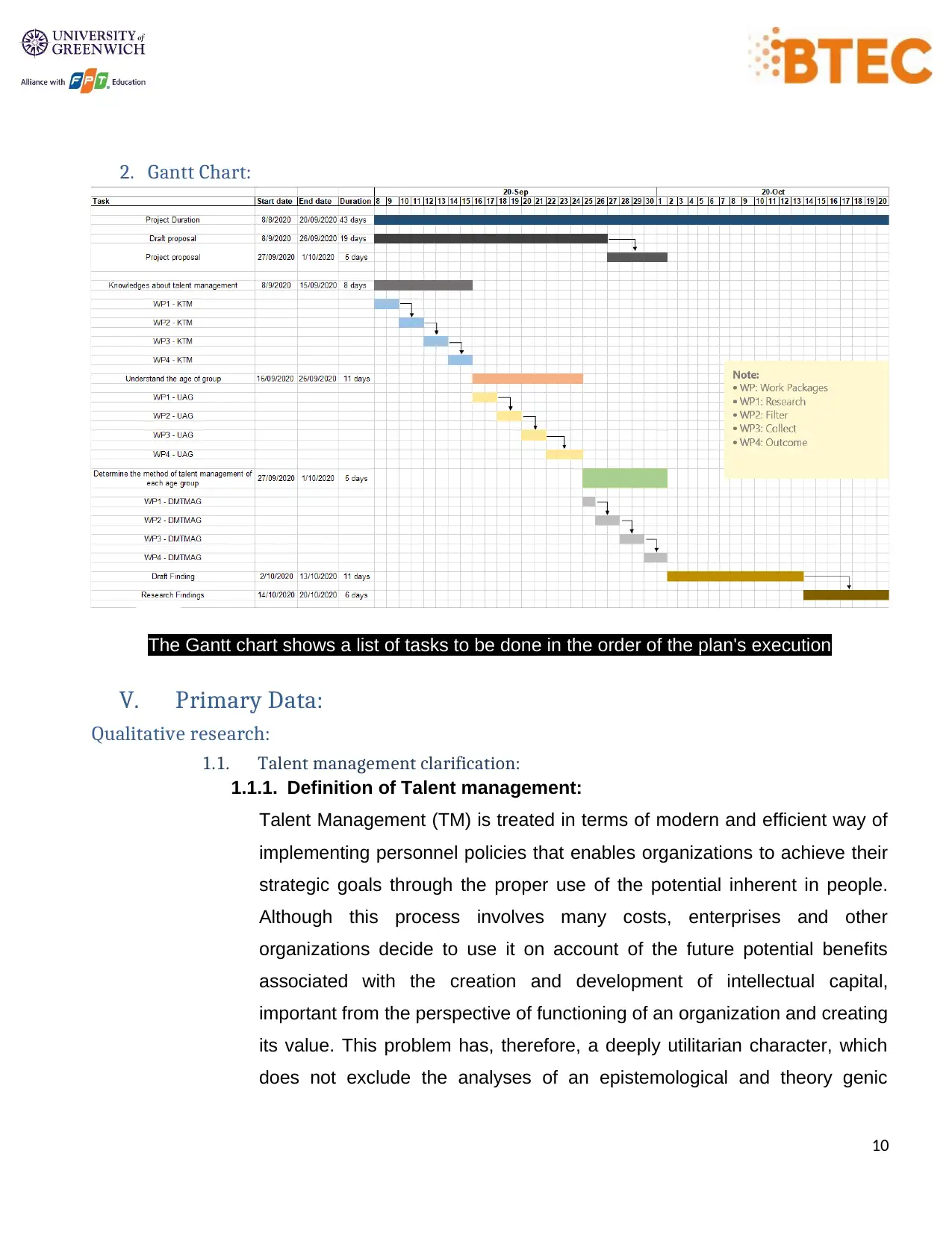
2. Gantt Chart:
The Gantt chart shows a list of tasks to be done in the order of the plan's execution
V. Primary Data:
Qualitative research:
1.1. Talent management clarification:
1.1.1. Definition of Talent management:
Talent Management (TM) is treated in terms of modern and efficient way of
implementing personnel policies that enables organizations to achieve their
strategic goals through the proper use of the potential inherent in people.
Although this process involves many costs, enterprises and other
organizations decide to use it on account of the future potential benefits
associated with the creation and development of intellectual capital,
important from the perspective of functioning of an organization and creating
its value. This problem has, therefore, a deeply utilitarian character, which
does not exclude the analyses of an epistemological and theory genic
10
The Gantt chart shows a list of tasks to be done in the order of the plan's execution
V. Primary Data:
Qualitative research:
1.1. Talent management clarification:
1.1.1. Definition of Talent management:
Talent Management (TM) is treated in terms of modern and efficient way of
implementing personnel policies that enables organizations to achieve their
strategic goals through the proper use of the potential inherent in people.
Although this process involves many costs, enterprises and other
organizations decide to use it on account of the future potential benefits
associated with the creation and development of intellectual capital,
important from the perspective of functioning of an organization and creating
its value. This problem has, therefore, a deeply utilitarian character, which
does not exclude the analyses of an epistemological and theory genic
10
Paraphrase This Document
Need a fresh take? Get an instant paraphrase of this document with our AI Paraphraser
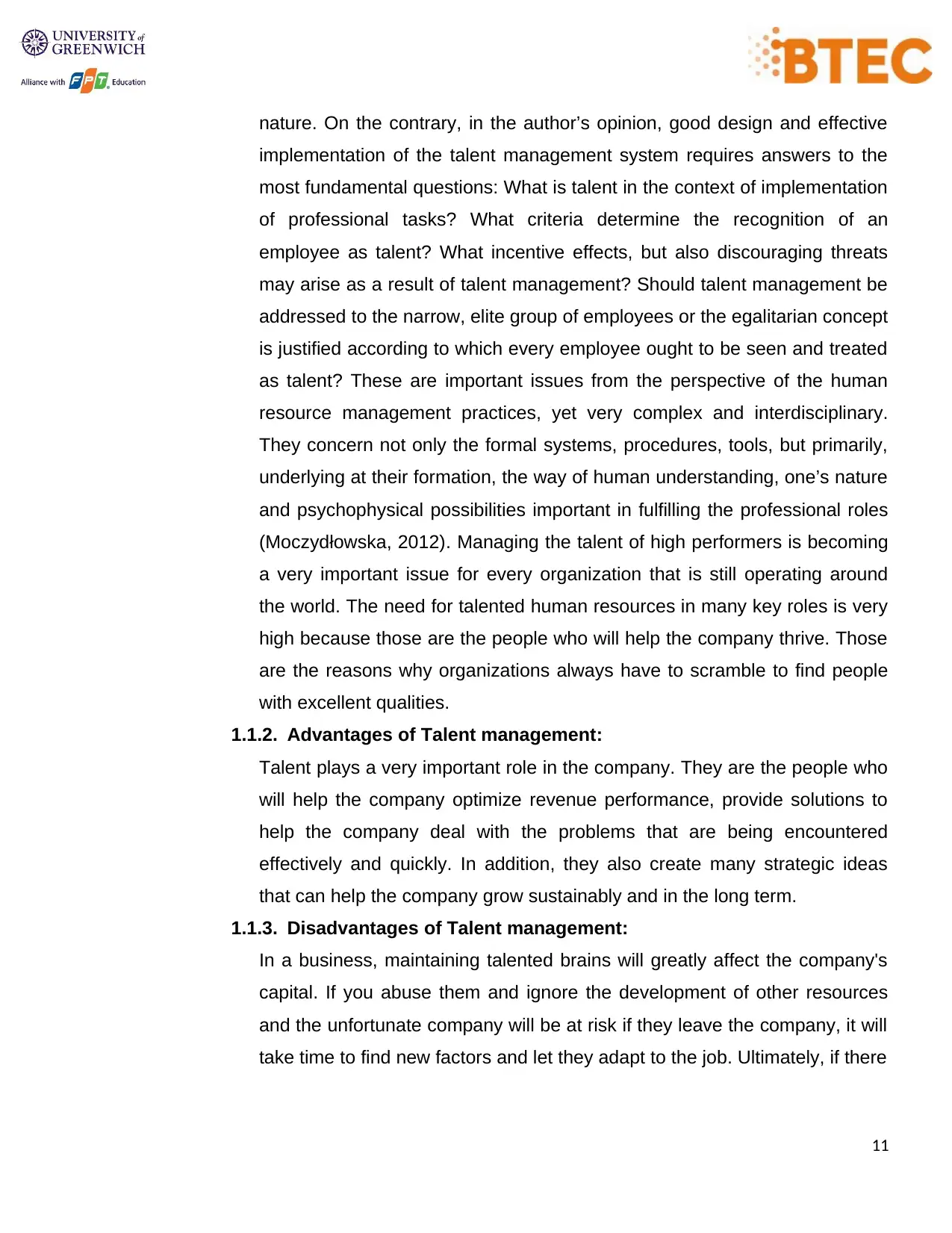
nature. On the contrary, in the author’s opinion, good design and effective
implementation of the talent management system requires answers to the
most fundamental questions: What is talent in the context of implementation
of professional tasks? What criteria determine the recognition of an
employee as talent? What incentive effects, but also discouraging threats
may arise as a result of talent management? Should talent management be
addressed to the narrow, elite group of employees or the egalitarian concept
is justified according to which every employee ought to be seen and treated
as talent? These are important issues from the perspective of the human
resource management practices, yet very complex and interdisciplinary.
They concern not only the formal systems, procedures, tools, but primarily,
underlying at their formation, the way of human understanding, one’s nature
and psychophysical possibilities important in fulfilling the professional roles
(Moczydłowska, 2012). Managing the talent of high performers is becoming
a very important issue for every organization that is still operating around
the world. The need for talented human resources in many key roles is very
high because those are the people who will help the company thrive. Those
are the reasons why organizations always have to scramble to find people
with excellent qualities.
1.1.2. Advantages of Talent management:
Talent plays a very important role in the company. They are the people who
will help the company optimize revenue performance, provide solutions to
help the company deal with the problems that are being encountered
effectively and quickly. In addition, they also create many strategic ideas
that can help the company grow sustainably and in the long term.
1.1.3. Disadvantages of Talent management:
In a business, maintaining talented brains will greatly affect the company's
capital. If you abuse them and ignore the development of other resources
and the unfortunate company will be at risk if they leave the company, it will
take time to find new factors and let they adapt to the job. Ultimately, if there
11
implementation of the talent management system requires answers to the
most fundamental questions: What is talent in the context of implementation
of professional tasks? What criteria determine the recognition of an
employee as talent? What incentive effects, but also discouraging threats
may arise as a result of talent management? Should talent management be
addressed to the narrow, elite group of employees or the egalitarian concept
is justified according to which every employee ought to be seen and treated
as talent? These are important issues from the perspective of the human
resource management practices, yet very complex and interdisciplinary.
They concern not only the formal systems, procedures, tools, but primarily,
underlying at their formation, the way of human understanding, one’s nature
and psychophysical possibilities important in fulfilling the professional roles
(Moczydłowska, 2012). Managing the talent of high performers is becoming
a very important issue for every organization that is still operating around
the world. The need for talented human resources in many key roles is very
high because those are the people who will help the company thrive. Those
are the reasons why organizations always have to scramble to find people
with excellent qualities.
1.1.2. Advantages of Talent management:
Talent plays a very important role in the company. They are the people who
will help the company optimize revenue performance, provide solutions to
help the company deal with the problems that are being encountered
effectively and quickly. In addition, they also create many strategic ideas
that can help the company grow sustainably and in the long term.
1.1.3. Disadvantages of Talent management:
In a business, maintaining talented brains will greatly affect the company's
capital. If you abuse them and ignore the development of other resources
and the unfortunate company will be at risk if they leave the company, it will
take time to find new factors and let they adapt to the job. Ultimately, if there
11
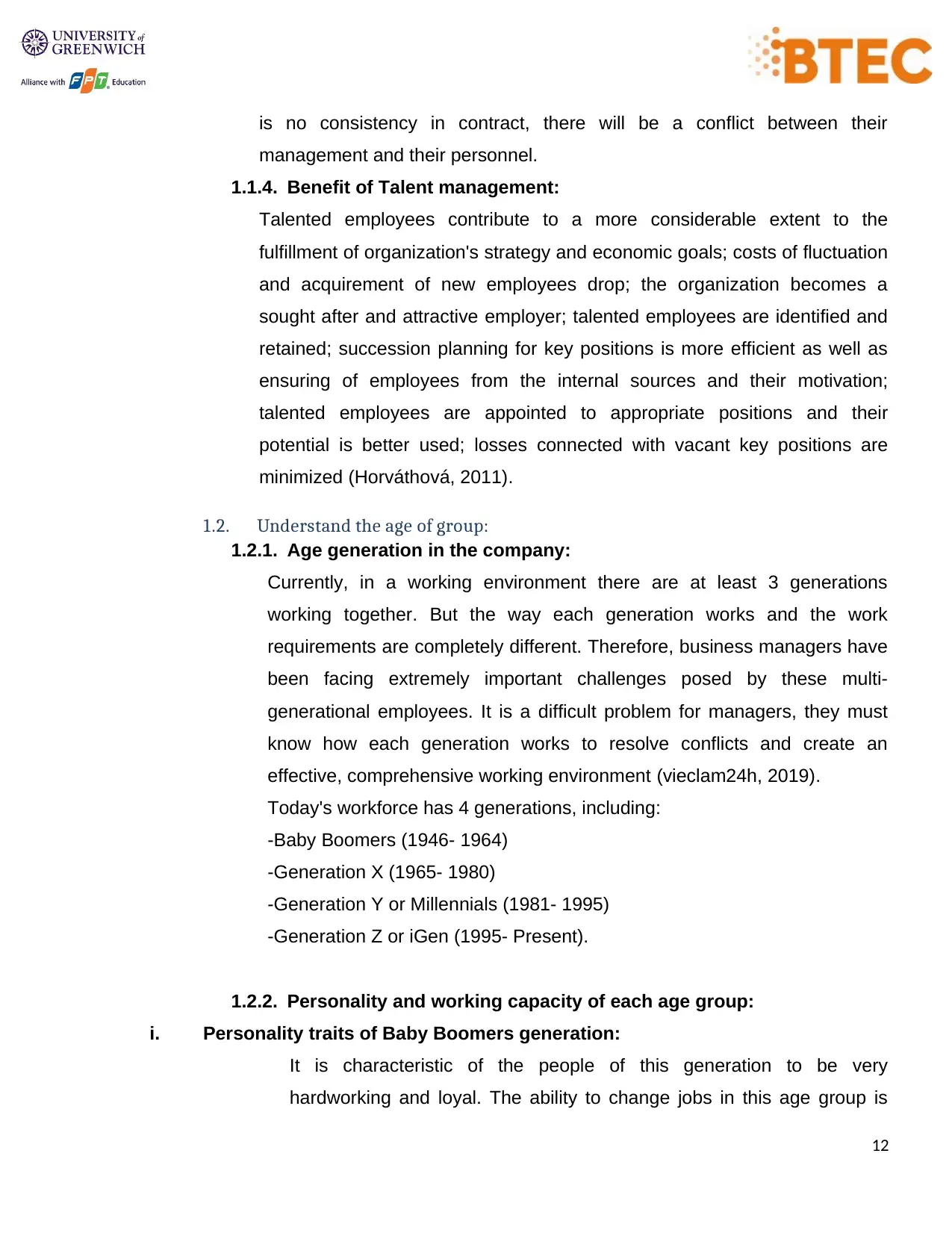
is no consistency in contract, there will be a conflict between their
management and their personnel.
1.1.4. Benefit of Talent management:
Talented employees contribute to a more considerable extent to the
fulfillment of organization's strategy and economic goals; costs of fluctuation
and acquirement of new employees drop; the organization becomes a
sought after and attractive employer; talented employees are identified and
retained; succession planning for key positions is more efficient as well as
ensuring of employees from the internal sources and their motivation;
talented employees are appointed to appropriate positions and their
potential is better used; losses connected with vacant key positions are
minimized (Horváthová, 2011).
1.2. Understand the age of group:
1.2.1. Age generation in the company:
Currently, in a working environment there are at least 3 generations
working together. But the way each generation works and the work
requirements are completely different. Therefore, business managers have
been facing extremely important challenges posed by these multi-
generational employees. It is a difficult problem for managers, they must
know how each generation works to resolve conflicts and create an
effective, comprehensive working environment (vieclam24h, 2019).
Today's workforce has 4 generations, including:
-Baby Boomers (1946- 1964)
-Generation X (1965- 1980)
-Generation Y or Millennials (1981- 1995)
-Generation Z or iGen (1995- Present).
1.2.2. Personality and working capacity of each age group:
i. Personality traits of Baby Boomers generation:
It is characteristic of the people of this generation to be very
hardworking and loyal. The ability to change jobs in this age group is
12
management and their personnel.
1.1.4. Benefit of Talent management:
Talented employees contribute to a more considerable extent to the
fulfillment of organization's strategy and economic goals; costs of fluctuation
and acquirement of new employees drop; the organization becomes a
sought after and attractive employer; talented employees are identified and
retained; succession planning for key positions is more efficient as well as
ensuring of employees from the internal sources and their motivation;
talented employees are appointed to appropriate positions and their
potential is better used; losses connected with vacant key positions are
minimized (Horváthová, 2011).
1.2. Understand the age of group:
1.2.1. Age generation in the company:
Currently, in a working environment there are at least 3 generations
working together. But the way each generation works and the work
requirements are completely different. Therefore, business managers have
been facing extremely important challenges posed by these multi-
generational employees. It is a difficult problem for managers, they must
know how each generation works to resolve conflicts and create an
effective, comprehensive working environment (vieclam24h, 2019).
Today's workforce has 4 generations, including:
-Baby Boomers (1946- 1964)
-Generation X (1965- 1980)
-Generation Y or Millennials (1981- 1995)
-Generation Z or iGen (1995- Present).
1.2.2. Personality and working capacity of each age group:
i. Personality traits of Baby Boomers generation:
It is characteristic of the people of this generation to be very
hardworking and loyal. The ability to change jobs in this age group is
12
⊘ This is a preview!⊘
Do you want full access?
Subscribe today to unlock all pages.

Trusted by 1+ million students worldwide
1 out of 21
Related Documents
Your All-in-One AI-Powered Toolkit for Academic Success.
+13062052269
info@desklib.com
Available 24*7 on WhatsApp / Email
![[object Object]](/_next/static/media/star-bottom.7253800d.svg)
Unlock your academic potential
Copyright © 2020–2025 A2Z Services. All Rights Reserved. Developed and managed by ZUCOL.





